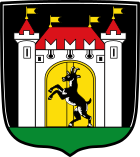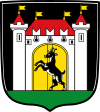Haunsheim
| coat of arms | Germany map | |
|---|---|---|

|
Coordinates: 48 ° 36 ' N , 10 ° 22' E |
|
| Basic data | ||
| State : | Bavaria | |
| Administrative region : | Swabia | |
| County : | Dillingen on the Danube | |
| Management Community : | Gundelfingen on the Danube | |
| Height : | 445 m above sea level NHN | |
| Area : | 17.81 km 2 | |
| Residents: | 1596 (Dec. 31, 2019) | |
| Population density : | 90 inhabitants per km 2 | |
| Postal code : | 89437 | |
| Primaries : | 09072, 09077 | |
| License plate : | DLG, WHO | |
| Community key : | 09 7 73 137 | |
| Community structure: | 3 parts of the community | |
| Association administration address: | Professor-Bamann-Str. 22 89423 Gundelfingen adDonau |
|
| Website : | ||
| Mayor : | Christoph Mettel ( CSU ) | |
| Location of the community Haunsheim in the district of Dillingen an der Donau | ||
Haunsheim (Schwäbisch Hausa ) is a municipality and a village in the Swabian district of Dillingen on the Danube .
geography
Haunsheim is located at the gateway to the Bachtal , an eastern branch of the Swabian Alb . To the south the valley opens into the wide Danube plain .
The municipality has three officially named municipal parts (the type of settlement is indicated in brackets ):
- Haunsheim ( parish village )
- Unterbechingen (parish village)
- Albhof ( wasteland )
The municipality consists of the districts Haunsheim and Unterbechingen.
Adjacent communities are the city of Gundelfingen an der Donau , the city of Lauingen , Medlingen , Wittislingen and Bachhagel .
history
Early history
Around Haunsheim and Unterbechingen there are numerous archaeological sites that are not uninteresting in their history. They comprise a total of 17 burial mounds from prehistoric times (4 pieces: 48 ° 35 ′ 37.4 ″ N , 10 ° 21 ′ 29 ″ E , 8 pieces: 48 ° 37 ′ 14.8 ″ N , 10 ° 21 ′ 52.4 ″ O , 5 pieces: 48 ° 36 ′ 56.9 ″ N , 10 ° 20 ′ 19.9 ″ E ), 2 square entrenches ( 48 ° 36 ′ 24.7 ″ N , 10 ° 19 ′ 57.6 ″ E , 48 ° 35 ′ 17.8 ″ N , 10 ° 21 ′ 10.7 ″ E ) and an early medieval rampart ( 48 ° 36 ′ 28.4 ″ N , 10 ° 22 ′ 43.4 ″ E )
Rulership history
In the 16th and 17th centuries, Haunsheim was under the rule of the Swabian Imperial Knighthood . The Reichspfennigmeister Zacharias Geizkofler bought Haunsheim in 1600 and from then on called himself Geizkofler on Haunsheim and Reiffenegg. As the owner of the rulership, he introduced the Evangelical Lutheran denomination in Haunsheim in 1603, which has remained unchanged to this day.
In 1666, through the marriage of the granddaughter Zacharias Geizkofler, the rule of Haunsheim came to the barons of Racknitz . With the Rhine Confederation Act in 1806, the place came to the Kingdom of Bavaria . In the course of the administrative reforms in Bavaria, today's municipality was created with the municipal edict of 1818 .
In 1823 Johann Gottlieb Baron von Süsskind from Augsburg , who had previously bought the neighboring, also evangelical rule of Bächingen , acquired Haunsheim Castle and the property belonging to it and had it redesigned in a neo-Gothic style to suit his taste . In 1849 his daughter Amalie Freifrau vom Holtz inherited it. Today the castle is owned by the Barons von Hauch .
Incorporations
On July 1, 1974, the previously independent community of Unterbechingen was incorporated.
Population development
- 1961: 1433 inhabitants
- 1970: 1492 inhabitants
- 1987: 1482 inhabitants
- 1991: 1576 inhabitants
- 1995: 1602 inhabitants
- 2000: 1594 inhabitants
- 2005: 1611 inhabitants
- 2010: 1564 inhabitants
- 2015: 1591 inhabitants
Between 1988 and 2018, the municipality grew from 1,502 to 1,592 by 90 inhabitants or 6%.
politics
The community is a member of the Gundelfingen an der Donau administrative association .
mayor
The first mayor has been Christoph Mettel (CSU) since May 2014, and the second mayor is Georg Urban (OT Unterbechingen). Mettel was elected for a further six years on March 15, 2020 with 87.2% of the vote.
Municipal council
The municipal council consists of twelve members. The distribution of seats in the municipal council changed little in the 2014 local elections compared to 2008 and is as follows:
- Free electoral association: 4 seats (2008: 4 seats)
- Bürgerblock OT Unterbechingen: 5 seats (2008: 4 seats)
- CSU: 3 seats (2008: 4 seats)
coat of arms
|
Blazon : “In black on green ground, a red-roofed, silver gate between two tin towers with red pointed roofs, on top of which are golden weather vanes; in front of the closed golden gate a jumping black gemsbok. "
The gate represents the castle of Haunsheim, which the local lords built from 1601 to 1604. The billy goat is taken from the family coat of arms of the Geizkofler and stands for the name of the local rulers. The part of the name 'avarice' stands for 'goat'. From 1655 there is an impression of a seal with the inscription SIGILLVM COMMVNITATIS IN HAVNSHEIM . |
|
Culture and sights
- Evangelical Trinity Church in Haunsheim, built in the Renaissance style from 1606 to 1609 according to plans by Joseph Heintz the Elder. Ä. with the participation of Elias Holl , based closely on the strict classicistic architectural style of the imperial court. The HC Branmann organ, built in 1878 and recently restored, is also worth mentioning.
- Cemetery in Haunsheim , laid out according to plan (row graves): Traditionally, every grave has a wooden, brightly painted cross (in black, white and green); this symbolically implements the idea of the absolute equality of all people in heaven.
- Haunsheim Castle owned by the Barons von Hauch , a regular venue for concerts.
- Old forge from the 16th century in the center of the village, faithfully restored.
- Restored grain store (Swabian Korastadl ), used for various events.
- Rectory built in the 17th century.
Economy and Infrastructure
Economy including agriculture and forestry
In 1998, according to official statistics, there were no employees at the place of work in the manufacturing industry 41 and in the trade and transport sector. There were a total of 573 employees at the place of residence subject to social insurance contributions. There were two companies in the manufacturing sector and one in the construction sector. In addition, in 1999 there were 25 farms with an agricultural area of 990 ha, of which 916 ha were arable land.
The municipal tax receipts in 1999 amounted to the equivalent of 696,000 €, of which the trade tax receipts (net) amounted to the equivalent of 44,000 €.
education
The following institutions exist (as of: 1999):
- Kindergarten: 56 kindergarten places with 46 children
- Zacharias-Geizkofler Elementary School
Web links
Individual evidence
- ↑ "Data 2" sheet, Statistical Report A1200C 202041 Population of the municipalities, districts and administrative districts 1st quarter 2020 (population based on the 2011 census) ( help ).
- ^ Haunsheim community in the local database of the Bavarian State Library Online . Bayerische Staatsbibliothek, accessed on August 31, 2019.
- ↑ Otto Braasch : Swabia: Ensembles, architectural monuments, archaeological site monuments . Oldenbourg Verlag, 1986, pp. 153-154.
- ↑ a b c Federal Statistical Office (ed.): Historical municipality directory for the Federal Republic of Germany. Name, border and key number changes in municipalities, counties and administrative districts from May 27, 1970 to December 31, 1982 . W. Kohlhammer, Stuttgart / Mainz 1983, ISBN 3-17-003263-1 , p. 769 .
- ↑ Municipal Council. Haunsheim community, accessed on August 14, 2020 .
- ↑ Results of the 2014 local elections from the Bavarian State Office for Statistics
- ^ Entry on the coat of arms of Haunsheim in the database of the House of Bavarian History








